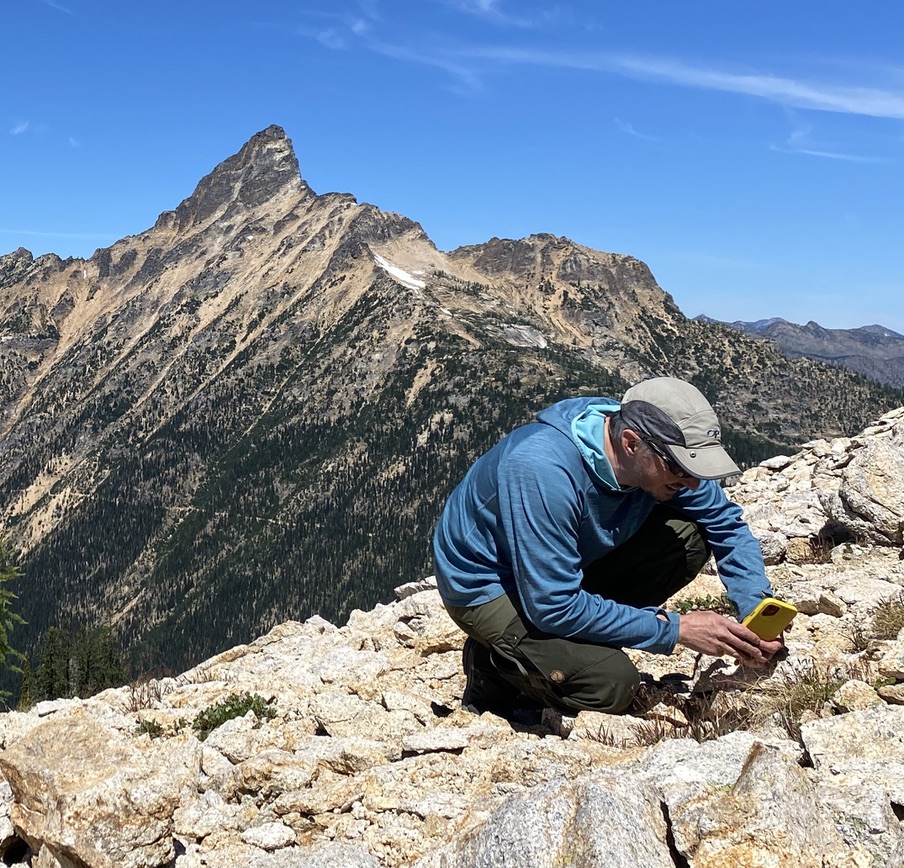
Q&A with Aaron Wells: The Whitebark Pine Project
For Citizen Science Month, we’d like to introduce you to Aaron Wells, vegetation ecologist with AECOM Technical Services in Winthrop, Washington. He is a lover of all things alpine, including skiing, rock climbing, hiking and professional botanizing at Elfinwood Ecology. Aaron manages “The Whitebark Pine Project” (WBPP), a citizen science project to raise awareness of whitebark pine and engage the public in conservation research. He’s also been involved with starting up WPEF’s “Five-Needle Pines Along the Pacific Crest Trail” community science project. Learn more in this Q&A about the WBPP project and how to contribute your own data.
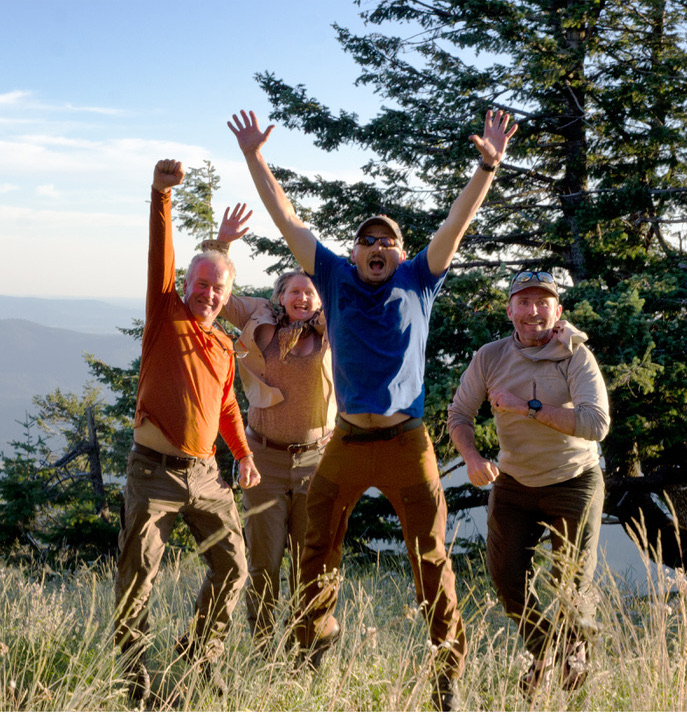
Aaron Wells (center, in blue shirt) and field crew members take a break to jump with joy, while conducting vegetation surveys at Ragged Ridge in Mount Spokane State Park last year
When did you first become interested in studying whitebark pine?
I first encountered whitebark pine during postdoctoral research at Montana State University. During this project, we mapped the vegetation and soils of the Wind River Range in Wyoming, including whitebark pine plant communities. Whitebark pine is an ambassador of the subalpine and alpine zones across western North America and symbolic of the delicate balance of nature.
What motivated you to start a citizen science project in this area?
While living in Alaska, I coordinated the “Flora of Chugach State Park” citizen science project for the Alaska Native Plant Society. It was here that I was introduced to the iNaturalist app to engage the public in recording species data and observations. This project showed me the value in using citizen science to further conservation efforts. Having worked in whitebark pine forests earlier, it was an obvious choice for a new citizen science project when I moved to Washington.
What is the “Whitebark Pine Project” (WBPP)?
The WBPP is a citizen science project to raise awareness about the ecology and threats to whitebark pine and a means for the public to contribute data to whitebark pine research. It’s important to note this project also includes other species related to whitebark pine ecology (i.e., Clark’s nutcracker, pests/diseases, secondary disease hosts like Ribes).
The project components include:
- The WBPP iNaturalist project where the public can record observations, make research-grade identifications and read updates in the project journal.
- The WBPP companion website with a best practices guide for documenting and uploading observations and an identification guide to the five-needle pines of western North America.
- A pilot study demonstrating the utility of citizen science data for conservation science.
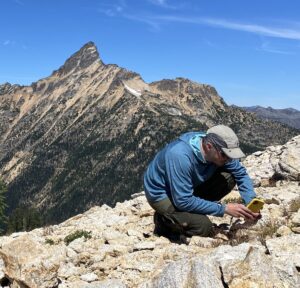
Aaron recording an iNaturalist observation with his cell phone
How can people get involved and contribute data?
There are two major ways people can get involved with this project. First, anyone can contribute observations of whitebark pine and related species to the project using the iNaturalist app. Join the project on iNaturalist and follow the best practices guide on the companion website.
Second, we need help from experienced naturalists and scientists to make research-grade identifications. Research grade means at least two people agree on an identification, which indicates a higher confidence in the data. Learn more about making identifications in this video.
How many observations have there been to date?
As of February 2023, there were 2,791 observations of whitebark pine on the iNaturalist project with 71% of those observations at research grade. A broad geographic range is represented from as far north as Mount Robson Provincial Park, B.C., south to the John Muir Wilderness Area in California, east to the Gros Ventre Range in Wyoming and west to Boulder Peak in the Klamath National Forest in northern California.
I’d also like to recognize the five people with the most research-grade identifications: Drew Meyer (262); user wright (219); Chris Earle (206); Peter Achuff (149); and user grnleaf (98); and the five people with the most research-grade observations: Randy Moody (59); John Brew (53); Jon Reberlio (51); Brian Starzomski (47); and Chris Earle (47).
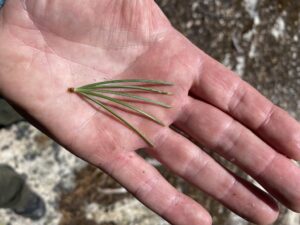
Citizen scientists can follow the best practices guide to record high-quality observations like recording number of needles and length
What are some of the limitations of crowdsourcing data?
Crowdsourced data can be a challenge to use for research purposes. For example, there may be misidentifications, data may be spatially skewed towards areas with easy access (i.e., trails, roads) and data is unstructured without a statistical sampling methodology used. To this end, I am working on adding a component that is statistically rigorous and relies on volunteers to collect the data.
Also, through educating the public, I hope to increase the number of high-quality observations. Lastly, I’m hoping to increase the number of scientists involved in the project on iNaturalist to provide identifications of observations and look for collaboration opportunities.
How can this data be used for whitebark pine restoration?
At the most basic level, the project data can be used to supplement existing datasets to understand where whitebark pine occurs and refine the range map for this species. The data also provide a potential mechanism for real-time monitoring of whitebark pine for disease and pests. For example, if many people are posting observations of white pine blister rust in a specific area, this can alert land managers early on to an outbreak they may not be aware of.
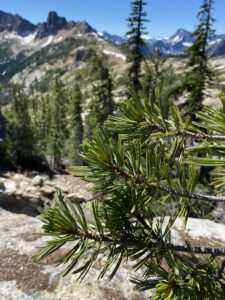
Whitebark pine in the North Cascades where Aaron is starting up a new long-term monitoring program on five-needle pines
Have you had any other interesting observations or findings?
The WBPP only includes whitebark pine observations within the currently known range of the species. For observations outside this range, I also started the “Whitebark Pine Outside Published Range” project on iNaturalist to flag potential range extensions or erroneous observations. These observations require an additional layer of scrutiny, specifically if the habitat is suitable for whitebark pine. I’ve found observations that are undoubtedly whitebark pine and well outside the known range, which represent a significant range extension.
What are your plans to expand the project?
I recently was awarded funding from the Washington Native Plant Society for a related citizen science project. This pilot project will focus on developing a long-term monitoring program in the North Cascade mountains to collect data and assess the status and trends of five-needle pines. Stay tuned to my website Elfinwood Ecology or email me for more details.


